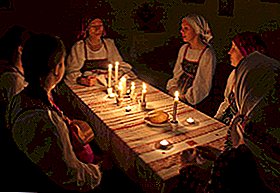 Russian folklore is the work of the people. It contains the worldview of thousands of people who once inhabited the territory of our state. Their way of life, love for the Motherland and their home, feelings and experiences, dreams and upheavals - all this has been passed from mouth to mouth for centuries and gives us a connection with our ancestors.
Russian folklore is the work of the people. It contains the worldview of thousands of people who once inhabited the territory of our state. Their way of life, love for the Motherland and their home, feelings and experiences, dreams and upheavals - all this has been passed from mouth to mouth for centuries and gives us a connection with our ancestors.
The heritage of our people is multifaceted and diverse. Conventionally, the genres of Russian folklore are divided into two groups, including many kinds: ritual and non-ritual folklore.
Ritual folklore
This group of folk works, in turn, is divided into two categories:
- Calendar folklore - a reflection of the way of life: agricultural work, Christmas carols, Pancake week and Kupala rituals. Through this genre of Russian folklore, our ancestors turned to Mother Earth and other deities, asking her for protection, good harvest and grace.
- Family folklorewho described the order of life of each person: the creation of a family and the birth of a child, service in the army, death. Magnificent songs, wedding, funeral and recruit lamentations - for each event there was a special ceremony that gave a special solemnity and mood.
Non-ritual folklore
It is a more numerous group of works of folk art and includes 4 subspecies:
I. Folklore drama
- Petrushka Theater - ironic street theatrical performances in the person of one actor;
- Christmas and religious drama - performances on the theme of the Nativity of Christ and other events.
Ii. Folk poetry
- Bylinas: songs-legends, narrating about the heroes of antiquity, who defended their homeland, their exploits and valor. Bylina about Ilya Muromets and the Nightingale the Robber is one of the most famous. Colorful heroes, colorful epithets and melodic tune of the narrator draw a vivid image of the Russian hero, a representative of the freedom-loving free people. The most famous are two cycles of Russian epics: the Kiev cycle and the Novgorod cycle.
- Historical songs describe the real events that occurred in ancient times. Yermak, Pugachev, Stepan Razin, Ivan the Terrible, Boris Godunov - these and many other great people and their deeds went down not only in history, but also in folk art.
- Chastushka - ironic quatrains, clearly assessing, and often making fun of life situations or phenomena.
- Lyrical songs - the responses of ordinary people to events in the political and public life of the state, the relationship of the peasant and the gentleman, the inviolable principles of the peasants' way of life, people's morality. Frequent (dance) and lingering, daring and beautiful melodious, they are all deep in content and emotional intensity, forcing even the most callous nature to respond.
Iii. Folk prose
The brightest example familiar to each of us since childhood is fairy tales. Good and evil, justice and meanness, feat and cowardice are all intertwined here. And only the pure and open heart of the protagonist is able to overcome all adversity.
Iv. Folklore of speech situations.
A very diverse group. Here and proverbs, which are popular aphorisms, and puzzles that develop thinking, and children's folklore (rashes, pestushki, counting glasses, tongue twisters and other types of children's folklore), which helps through the game and fun to the best development of children.
This is only a small part of the heritage that our ancestors left. Their work has great cultural value. It does not matter to which particular genre of Russian folklore is a particular masterpiece. All of them are united by one common feature - in each the principles of life are concentrated: love, kindness and freedom. That without which the very existence of man is not conceivable.

Leave Your Comment